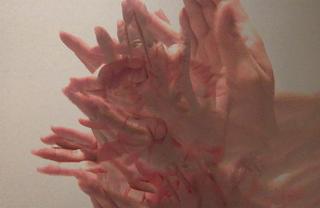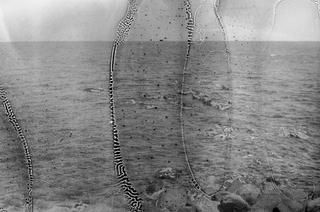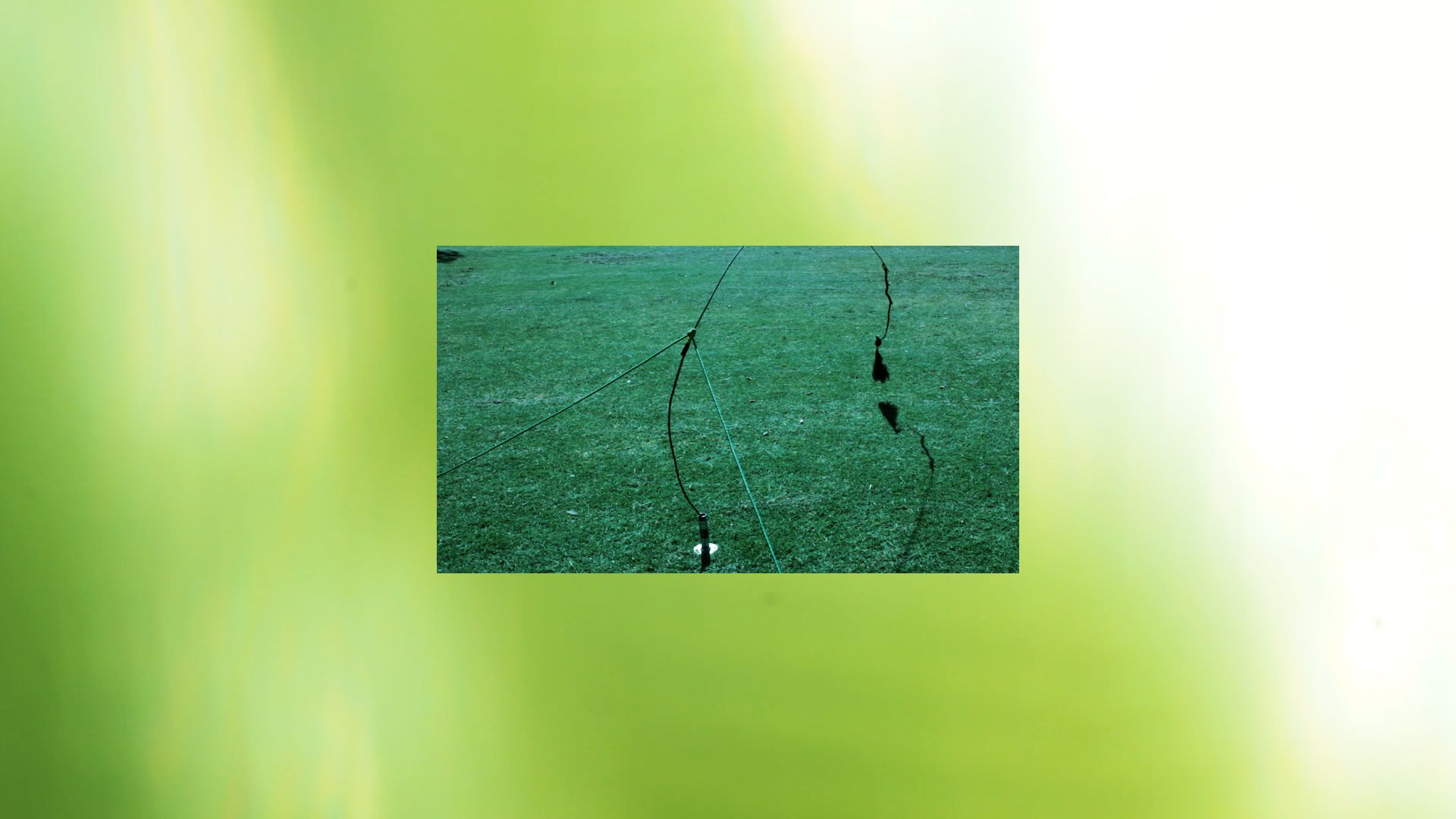

the humbleness and the cut away
Francis Plagne, Anna Schwann, Jacqui Shelton, Bixiao Zhang
1 Mar–31 May 2022
Curated by Martina Copley
the humbleness and the cut away [1]
*
Writing lying down.
Thinking about making stuff and not making stuff
“Trying to find a pen that works in order to scribble a note on a tiny, crumpled piece of paper.” [2]
Stopped thinking and made marks, some accidental, in the print out. Looking at the back page, at the circlings and crossings out, and inked looping arrows that link to various ways of moving through, with and inside. Looking for language, entering into a relationship with the forms and determinations of things, is a doing-in-common.
Writing choral, as a form of friendship and reauthoring, I lean into Lydia Davis, Moyra Davey, Elieen Myles and others.
Gestural castings. Asides to asides.
*
And then, I wrote something about xxx. “I can’t read that, which is a shame.” [3]
Lost.
“They are lost from me and where I am, but they are also not gone. They are somewhere else, and they are there to someone else […], only not where I am," [4]
Not lost.
“I must go out”. [5]
Jacqui Shelton, The grit of the landscape, 2022. Digital video and Inket prints, 4:40min. Courtesy the artist.
JACQUI SHELTON
This work was shot on black and white film, at bodies of water I regularly swim in on Djaara and Bunurong country. The undeveloped film was then soaked for a week in water collected from these locations, to allow the material and mineral makeup of these sites to alter and impress upon the visual image of them. This soaking in liquids with various organic and chemical contributors, causes the silver emulsion of the film to slip and move, producing a grain and patterning onto the image of the landscape not unlike a hidden punctuation in the grammar of representation. As the films soaked, I too was immersed in these waters, and through this wanted to consider a history of landscape photography that is implicitly based on distance, immediacy, and capture. With a longer timeframe of 'exposure' (to light, and to subsequent minerals and liquids), could a traditionally Western tradition of imaging place be re-inscribed with the invisible forces of fluidity and minerality?
STARNGE BTAH
“The difficult orientation created in Greek thought [how to articulate both being and becoming, the eternal and the temporal] is not questioned or resolved in Chinese thought: rather it is dissolved there:
in this strange bath it is no longer recognisable.” [6]
& stay warm
Françios and I.
in that bath.
Bixiao Zhang, 千手觀音 (The 1000 armed Sound Perceiver), 2021. Online Streaming Performance, sound, 5:52min. Courtesy the artist.
BIXIAO ZHANG
A video performance of the hand gestures of the “1000 armed Guanyin” (Avalokiteshvara from Mahayana Buddhism), 千手觀音 The 1000 armed Sound Perceiver (2021) explores the co-affecting relations between the user and their digital media bodies. The reverberating relations between digital media and users are performed through the infinitely multiplying, expanding, and contracting hand gestures, as they literally become “1000 armed”.
The work takes up poet Emily Dickinson’s line; “how life’s reverberation” (poem 1581), to suggest that that the co-affecting relations amongst electronic entities could be imagined as a reverberation of sound. Digital media and user mutually shape each other simultaneously.
Guanyin also means “sound perceiver” in Chinese, which also links with Alvin Lucier’s sound work “I am sitting in a room” (1981). For the “sound perceivers”, the world within and without are disregarded, replaced by a mutually circuitous understanding of “worlds as things we make and that make us”.
This understanding of the techno-human entity in digital media is driven by the sympathetic practice of “noself-hood”(coined by Zhang). As Guanyin is also the embodiment of compassion and shares the suffering of all beings by becoming like each of them, “noself-hood” is a self-abnegating being-hood [*] that identifies with each object contemplated. This paradoxical self diminution leads to self-expansion through the infinite ripples amongst beings and their environment.
As the “sound perceiver” considers the user as part of the digital network and vice versa, this work practices “noself-hood” in the circuitous digital world, a co-created being-hood that expands by folding.
.
[*] Being-hood is a neologism coined by Zhang to describe a manner of subjectivity that is not human-centric but rather merges entities typically seen as distinct eg. Zhang and AI, Zhang and online stores, Zhang and online image databases.
NO TENSES FOR TIME TRAVEL
“How to think about the opportunity of a moment, about breathing?” [7]
–––––––––––––––––––––––––––––––––––––––––––––––––––––––––––––––––––––––––––––––
INTERLUDE as a general rule, the interlude, in the classical sense, is a pause, a stop in the narrative; it is an effect, a figure of montage, produced subsequently to the shooting. to me, interludes are moments of distraction one might fall into while filming a subject, designated or determined as the main one.
with the film, it appears quite clearly that one can be led to follow a subject and become lost in another. [8]
–––––––––––––––––––––––––––––––––––––––––––––––––––––––––––––––––––––––––––––––
DOES THE BELONG WORLD IN YOU? [9]
In a story that is not mine, a woman is hospitalised because she sees multiple meanings of words. Imaginative play is her ailment. She senses “words heating up, expanding, exploding into pictures of things, shooting off in all directions, then flaming out, leaving behind cinders and husks, a litter of tiny, empty winged corpses, like scorched gnats or angels”. [10]
Then a doctor takes her language away leaving her with just the bare bones. Without her associative imagination – her private lexicon, words mean only what they mean.
Examine those words: “privacy of language”.
*
OBLIQUITY
Two days, sideaways and
“A breach of identity.” [11]
Giving the mundane its proper weight, minor occurrences buckle the framework.
Anna Schwann, Keen's Curry Ghost Branch That Fell and Nearly Killed the Cat, 2022. Flour, water, curry powder, uv light.
ANNA SCHWANN
More and more I am wrestling with the idea of taking up space, both as physical space in terms of making work that exists for an undetermined amount of years and then owning my own space as a valid participant in the conversation. Through this curatorial invitation for ‘Lost things and something from nothing’, that space up for the taking has been inverted because the further along I go, the more nothingness reveals itself. Nothingness is still a ‘something’ but it has a particular way of behaving between dimensions that make it difficult to pin, sometimes a cavernous yawning void, sometimes pressing against your skin as it fills a room. A space for ghosts.
Anna Schwann, When I think of the suburbs, I cry, 2022. Video, 4min. Courtesy the artist.
The two works presented serve as skewed memorials of events, ‘subtly twisted’ [1] by the use of provisional materials, making the outcome contingent on their behaviour. Contingency is a foray into possibility, which is equally geared toward positive as it is negative even though it is more commonly associated with the negative, for example: contingency plans never contain party supplies [2]. In terms of this project, the negative comes from taking an apophatic [3] view, unsaying what something IS in order to leave space for possibility. By resisting a defined path, there is a greater chance to uncover freshness.
Here is what I learned during this process:
Ostinato is Italian for obstinate.
Agnes Varda knows the art of eavesdropping.
Human bodies are 60% water content, not 90%
Nothing is an egg.
.
[1] Here I am borrowing the term ‘subtly twisted’ from an article by Reza Negarastani titled Contingency and Complicity. They use 13 variations of twist/twisted in a 4 page document, approx 3 per page if you want to be measured about it but actually there is the highest concentration of twists located on page 3 of the article.
[2] This is a crying shame.
[3] The term apophatic comes from apophatic theology, in which the concept of God is progressively undefined through language because of the opinion that we as humans could not possibly hope to know what ‘God’ actually is. This goes hand in hand with kataphatic theology which serves to do the opposite and define the qualities of God, the two perspectives create an evenly weighted tension.
NOT SURE WHAT TO CALL IT, PERHAPS MUSIC.
The active inclusion of noise in sound is called sawari. “The sawari is the apparatus of an obstacle itself”. [12]
What lies outside, behind or beyond?
Francis Plagne, Five Tapes, 2018-2020. Sound, 1:59:27min. Courtesy the artist.
FRANCIS PLAGNE
Much of my music - and most of what I do entirely solo - is recorded on a Yamaha 8 track cassette machine (the Portastudio 488) I’ve had since my early teens. Though I sometimes record and often edit digitally, this cassette machine remains my primary way of recording music at home. After years of working with it, I no longer see its sketchy fidelity and multi-tracking capabilities as limitations; rather, they form an essential part of how I approach recording.
After a break of several years where I didn’t have enough space in my domestic situation or time to regularly record at home, in the last four years I have returned to the practice of making multi-track recordings without a clear goal in mind (in terms of album release, etc.). These are often miniatures, no longer than a few minutes each. In recent years, my approach to these pieces is often (though not always) ‘improvised’ rather than planned out. That is, though they are built up through multi-tracking various instruments and other sounds performed or collected by myself, the first track is often put down to tape without a clear idea of how the piece will develop through this layering. Sometimes I eventually record over the top of the initial layer that was the impetus for the piece, or it moves very much into the background. A result of this more unplanned, spontaneous way of recording is that I often end up working on several pieces at once, as an element added to one piece suggests the beginning of another one
In addition to these miniatures (intended as standalone pieces), I also use the Yamaha machine for collecting sounds that are later used as source material for pieces built up in more of a collage style either digitally or through transfer to another tape, as well as to demo material intended to be professionally recorded and played with a band.
This sound file contains a selection of five tapes used between 2018 and 2020, presented in what I think is chronological order and without editing. The tapes contain pieces that appeared on my Rural Objects release (Hobbies Galore/Black Truffle/Horn of Plenty, 2019/2021), demos for my forthcoming band LP and some material used in making The Refrain (Black Truffle, 2022). The complete content of each tape is heard in its entirety, without editing (because the machine records at double speed, using both sides of the tape at once, each is around 22 minutes long); the ‘mix’ is close to arbitrary, as the faders, equalisations and pans were left in the same positions throughout (except for the occasional adjustment when something was unpleasantly loud, etc.).
THE ALMOST FORMED UNTHOUGHT [13]
[1] Emily Dickinson
[2] Moyra Davey, New York: New Directions, 2020, 21.
[3] Tacita Dean quoted in Hans Ulrich, “Tacita Dean”, The Conversation Series 28 (Cologne: Verlag der Buchhandlung Wather Kõnig, 2012), 19.
[4] Lydia Davis, “Lost Things”. In The Collected Stories of Lydia Davis. New York: Farrar, Straus and Giroux, 2009, 275.)
[5] Elieen Myles, “Sullivan’s Brain”. In I Must Be Living Twice. New York: Harper Collins, 2015, 211.
[6] Françios Jullien. The Book of Beginnings. New Haven and London: Yale University Press, 2005. Translated by Jody Gladding, 53.
[7] Françios Jullien. The Book of Beginnings. New Haven and London: Yale University Press, 2005. Translated by Jody Gladding, 17.
[8] Joëlle Tuerlinckx, LEXICON – a compendium of terms for Exhibition Matters/Materials. Brussels: WIELS, 2012, n.p.
[9] Bernadette Mayer, A Bernadette Mayer Reader. New York: New Directions, 1992.
[10] Deborah Eisenberg, “The Third Tower”. In Your Duck is My Duck: Stories. New York: Ecco, 2018, 179.
[11] Moyra Davey, Index Cards, London: Fitcarraldo, 2020, 21.
[12] Daiji Maruoka and Tatsuo Yoshikoshi, NOH. Japan: Hoikusha, 1969, 65.
[13] Patricia Lockwood, No One Is Talking About This. New York: Riverhead Books, 2021.








Blindside Mobile is a curated online platform for projects in the digital space by Victorian-based creatives.
the humbleness and the cutaway is a video and pdf sequence by Anna Schwann, a moving image composite video by Jacqui Shelton, extracted sound by Francis Plagne and a digital video loop by Bixiao Zhan curated by Martina Copley.
the humbleness and the cutaway is from Emily Dickinson though I can no longer recall or trace back to when or where I first read, and then noted, that particular phrase. As punctuation, it’s an ellipsis (...) signalling an omission, pause or sudden leap.
An aside, Barthesian gap or ‘irrelevant event’.
This program takes place on the land of the Wurundjeri people of the Kulin Nation. We recognise that sovereignty was never ceded - this land is stolen land. We pay respects to Wurundjeri Elders, past, present and emerging, to the Elders from other communities and to any other Aboriginal or Torres Strait Islanders who might encounter or participate in the program.
Francis Plagne is a musician from Melbourne whose work swings between songwriting and a variety of other approaches, including group improvisation, instrumental abstraction, and domestic musique concrète. He has been performing live regularly since 2005 and had released recordings on labels such as Albert's Basement, Breakdance the Dawn, Lost and Lonesome, Kye Records and his own Mould Museum. In addition to performing his own work either solo or with a band, he has performed and recorded in improvised and other arrangements with Andrew Chalk, Crys Cole, Dean Roberts, and Joe Talia, among others. Since 2011, he has occasionally convened a variably sized ensemble to perform scores by composers such as Manfred Werder, Christian Wolff and Toshi Ichiyanagi. He is also a member of Food Court, The Inevitable Orbit, the ocarina ensemble Waste Drink, and the improvising trio Bird Milk (with Rohan Drape and Maria Moles).
Anna Schwann works in an expanded sculptural practice that investigates the encounter between art and audience. Through themes of binary oppositions, resistance and failure she facilitates a conversation using sensory engaging tactics as means of connection. Taking a D.I.Y approach to technique, Schwann utilises provisional, accessible materials for making and uses everyday objects in her narrative.
Schwann’s work has been exhibited locally and interstate in artist-run spaces, milk bars, subways and toilets. Alongside her own practice she has worked on live and participatory events most recently with Long Prawn and Punctum INC, worked in theatre producing set design and costumes for shows in Melbourne Fringe Festival , Geelong Arts Centre and La Mama. In 2021 Schwann completed a Masters of Fine Art at RMIT, was recipient of the Evan Lowenstein Award and was accepted into the Situate Residency Program 2022.
Lives and works in Naarm and on Jaara land with grateful respect to the elders past, present and emerging as the traditional caretakers of these lands and waterways.
Jacqui Shelton is an artist and writer born on Barada Barna land, central QLD, and based in Narrm, Melbourne. My work uses text, performance, film-making and photography to explore the complications of performance and presence, and how voice, language, and image can collaborate or undermine one another. I am especially interested in how emotion and embodied experience can be made public and activated to reveal a complex politics of living-together, and the tensions this makes visible.
Bixiao Zhang (Frankie) is a digital artist and Ph.D. candidate at RMIT University living in Naarm (Melbourne). Her practice-led research, a fluid entity termed “The ElectroPoetics”, proposes a performative approach to digital media and algorithmic architecture, driven by the intersections of Chinese Shanshui (mountain-water) thought, feminist eco-poetics, and electro-dynamism. Her performative “Shan-shui” practice situates dynamic digital substrates for transversal modes of engagement and co-current mattering, an approach that accentuates tacit resonance as primordial modes of care. Bixiao won the 2021 Dean’s Award for her research project, her latest projects include artist residencies and exhibitions across Australia and Internationally.
Martina Copley is an artist and writer whose practice explores the poetics of compositional processes. She has worked with Sutton Projects, Propane, Bus Projects, RMIT Project Space, SEVENTH, West Space, City and Docklands Libraries, Melbourne Festival, and Liquid Architecture. She has co-produced two artist books and her writing (often with live readings) has been published by the Expanded Writers Collective, Runway Journal, no more poetry, the Australian Centre for Contemporary Art (ACCA), and Bloomsbury Academic. Martina is Chair Artistic Director at Blindside and lectures in contemporary art and writing at RMIT University, the Victorian College of the Arts, University of Melbourne and La Trobe College of Art & Design.
martinacopley.com




